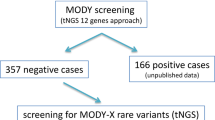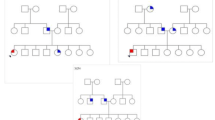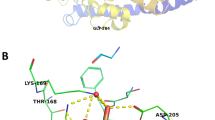Abstract
Aims
Maturity Onset Diabetes of the Young (MODY) is a monogenic form of diabetes with autosomal dominant inheritance pattern. The diagnosis of MODY and its subtypes is based on genetic testing. Our aim was investigating MODY by means of next-generation sequencing in the Tunisian population.
Methods
We performed a targeted sequencing of 27 genes known to cause monogenic diabetes in 11 phenotypically suspected Tunisian patients. We retained genetic variants passing filters of frequency in public databases as well as their probable effects on protein structures and functions evaluated by bioinformatics prediction tools.
Results
Five heterozygous variants were found in four patients. They include two mutations in HNF1A and GCK that are the causative genes of the two most prevalent MODY subtypes described in the literature. Other possible mutations, including novel frameshift and splice-site variants were identified in ABCC8 gene.
Conclusions
Our study is the first to investigate the clinical application of targeted next-generation sequencing for the diagnosis of MODY in Africa. The combination of this approach with a filtering/prioritization strategy made a step towards the identification of MODY mutations in the Tunisian population.

Similar content being viewed by others
References
Hattersley A, Bruining J, Shield J et al (2009) The diagnosis and management of monogenic diabetes in children and adolescents. Pediatr Diabetes 10:33–42. https://doi.org/10.1111/j.1399-5448.2009.00571.x
Kim SH (2015) Maturity-onset diabetes of the young: what do clinicians need to know? Diabetes Metab J 39:468–477. https://doi.org/10.4093/dmj.2015.39.6.468
Prudente S, Jungtrakoon P, Marucci A et al (2015) Loss-of-function mutations in APPL1 in familial diabetes mellitus. Am J Hum Genet 97:177–185. https://doi.org/10.1016/j.ajhg.2015.05.011
Anik A, Çatli G, Abaci A, Böber E (2015) Maturity-onset diabetes of the young (MODY): an update. J Pediatr Endocrinol Metab 28:251–263. https://doi.org/10.1515/jpem-2014-0384
Timsit J, Saint-Martin C, Dubois-Laforgue D, Bellanné-Chantelot C (2016) Searching for maturity-onset diabetes of the young (MODY): when and what for? Can J Diabetes 40:455–461. https://doi.org/10.1016/j.jcjd.2015.12.005
Shields BM, Hicks S, Shepherd MH et al (2010) Maturity-onset diabetes of the young (MODY): How many cases are we missing? Diabetologia 53:2504–2508. https://doi.org/10.1007/s00125-010-1799-4
Fendler W, Borowiec M, Baranowska-Jazwiecka A et al (2012) Prevalence of monogenic diabetes amongst Polish children after a nationwide genetic screening campaign. Diabetologia 55:2631–2635. https://doi.org/10.1007/s00125-012-2621-2
Irgens HU, Molnes J, Johansson BB et al (2013) Prevalence of monogenic diabetes in the population-based Norwegian childhood diabetes registry. Diabetologia 56:1512–1519. https://doi.org/10.1007/s00125-013-2916-y
Pihoker C, Gilliam LK, Ellard S et al (2013) Prevalence, characteristics and clinical diagnosis of maturity onset diabetes of the young due to mutations in HNF1A, HNF4A, and glucokinase: results from the SEARCH for diabetes in Youth. J Clin Endocrinol Metab 98:4055–4062. https://doi.org/10.1210/jc.2013-1279
Thanabalasingham G, Pal A, Selwood MP et al (2012) Systematic assessment of etiology in adults with a clinical diagnosis of young-onset type 2 diabetes is a successful strategy for identifying maturity-onset diabetes of the young. Diabetes Care 35:1206–1212. https://doi.org/10.2337/dc11-1243
Rubio-Cabezas O, Hattersley AT, Njølstad PR et al (2014) The diagnosis and management of monogenic diabetes in children and adolescents. Pediatr Diabetes 15:47–64. https://doi.org/10.1111/pedi.12192
Thanabalasingham G, Owen KR (2011) Diagnosis and management of maturity onset diabetes of the young (MODY). Bmj 343:d6044–d6044. https://doi.org/10.1136/bmj.d6044
Pearson ER, Starkey BJ, Powell RJ et al (2003) Mechanisms of disease genetic cause of hyperglycaemia and response to treatment in diabetes GLOSSARY. Lancet 362:1275–1281. https://doi.org/10.1016/S0140-6736(03)14571-0
Stride A, Shields B, Gill-carey O et al (2014) Cross-sectional and longitudinal studies suggest pharmacological treatment used in patients with glucokinase mutations does not alter glycaemia. Diabetologia 57:54–56. https://doi.org/10.1007/s00125-013-3075-x
Johansson S, Irgens H, Chudasama KK et al (2012) Exome sequencing and genetic testing for MODY. PLoS One 7:1–8. https://doi.org/10.1371/journal.pone.0038050
Ellard S, Lango Allen H, De Franco E et al (2013) Improved genetic testing for monogenic diabetes using targeted next-generation sequencing. Diabetologia 56:1958–1963. https://doi.org/10.1007/s00125-013-2962-5
Bonnefond A, Philippe J, Durand E et al (2014) Highly sensitive diagnosis of 43 monogenic forms of diabetes or obesity through one-step pcrbased enrichment in combination with next-generation sequencing. Diabetes Care 37:460–467. https://doi.org/10.2337/dc13-0698
Gao R, Liu Y, Gjesing AP et al (2014) Evaluation of a target region capture sequencing platform using monogenic diabetes as a study-model. BMC Genet 15:6–8. https://doi.org/10.1186/1471-2156-15-13
Alkorta-Aranburu G, Carmody D, Cheng YW et al (2014) Phenotypic heterogeneity in monogenic diabetes: the clinical and diagnostic utility of a gene panel-based next-generation sequencing approach. Mol Genet Metab 113:315–320. https://doi.org/10.1016/j.ymgme.2014.09.007
Amara A, Chadli-Chaieb M, Ghezaiel H et al (2012) Familial early-onset diabetes is not a typical MODY in several Tunisian patients. Tunis Med 90:882–887
Amara A, Chadli-chaieb M, Chaieb L et al (2014) Challenges for molecular diagnosis of familial early-onset diabetes in unexplored populations. Iran J Public Health 43:1011–1013
Khelifa SB, Martinez R, Dandana A et al (2018) Maturity onset diabetes of the young (MODY) in Tunisia: low frequencies of GCK and HNF1A mutations. Gene 651:44–48. https://doi.org/10.1016/j.gene.2018.01.081
Mcdonald TJ, Colclough K, Brown R et al (2011) Islet autoantibodies can discriminate maturity-onset diabetes of the young (MODY) from Type1 diabetes. Diabet Med 28:1028–1033. https://doi.org/10.1111/j.1464-5491.2011.03287.x
Pezzilli S, Ludovico O, Biagini T et al (2018) Insights from molecular characterization of adult patients of families with multigenerational diabetes. Diabetes 67:137–145. https://doi.org/10.2337/db17-0867
Desvignes J-P, Bartoli M, Delague V et al (2018) VarAFT: a variant annotation and filtration system for human next generation sequencing data. Nucleic Acids Res 46:W545–W553. https://doi.org/10.1093/nar/gky471
Wang K, Li M, Hakonarson H (2010) ANNOVAR: functional annotation of genetic variants from high-throughput sequencing data. Nucleic Acids Res 38:e164–e164. https://doi.org/10.1093/nar/gkq603
Desmet FO, Hamroun D, Lalande M et al (2009) Human splicing finder: an online bioinformatics tool to predict splicing signals. Nucleic Acids Res 37:1–14. https://doi.org/10.1093/nar/gkp215
Leman R, Gaildrat P, Gac GL et al (2018) Novel diagnostic tool for prediction of variant spliceogenicity derived from a set of 395 combined in silico/in vitro studies: an international collaborative effort. Nucleic Acids Res 46:7913–7923. https://doi.org/10.1093/nar/gky372
Fokkema IFAC, Taschner PEM, Schaafsma GCP et al (2011) LOVD v.2.0: the next generation in gene variant databases. Hum Mutat 32:557–563. https://doi.org/10.1002/humu.21438
Wildeman M, van Ophuizen E, den Dunnen JT, Taschner PEM (2008) Improving sequence variant descriptions in mutation databases and literature using the Mutalyzer sequence variation nomenclature checker. Hum Mutat 29:6–13. https://doi.org/10.1002/humu.20654
Hall TA (1999) BioEdit: a user-friendly biological sequence alignment editor and analysis program for Windows 95/98/NT. Nucleic Acids Symp Ser 41:95–98
Ellard S, De Franco E (2014) Next-generation sequencing for the diagnosis of monogenic diabetes and discovery of novel aetiologies. Front Diabetes 23:71–86. https://doi.org/10.1159/000362468
Castellana S, Fusilli C, Mazza T (2016) Chap. 22 A broad overview of computational methods for predicting the pathophysiological effects of non-synonymous variants. Methods Mol Biol 1415:423–440. https://doi.org/10.1007/978-1-4939-3572-7
Ellard S, Bellanné-Chantelot C, Hattersley AT (2008) Best practice guidelines for the molecular genetic diagnosis of maturity-onset diabetes of the young. Diabetologia 51:546–553. https://doi.org/10.1007/s00125-008-0942-y
Murphy R, Ellard S, Hattersley AT (2008) Clinical implications of a molecular genetic classification of monogenic beta-cell diabetes. Nat Clin Pract Endocrinol Metab 4:200–213. https://doi.org/10.1038/ncpendmet0778
George DCP, Chakraborty C, Haneef SAS et al (2014) Evolution- and structure-based computational strategy reveals the impact of deleterious missense mutations on MODY 2 (maturity-onset diabetes of the young, type 2). Theranostics 4:366–385. https://doi.org/10.7150/thno.7473
Bowman P, Flanagan SE, Edghill EL et al (2012) Heterozygous ABCC8 mutations are a cause of MODY. Diabetologia 1:123–127. https://doi.org/10.1007/s00125-011-2319-x
Ovsyannikova AK, Rymar OD, Shakhtshneider EV (2016) ABCC8-related maturity-onset diabetes of the young (MODY12): clinical features and treatment perspective. Diabetes Ther 7:591–600. https://doi.org/10.1007/s13300-016-0192-9
Riveline J-P, Rousseau E, Reznik Y et al (2012) Clinical and metabolic features of adult-onset diabetes caused by ABCC8 mutations. Diabetes Care 35:248–251. https://doi.org/10.2337/dc11-1469
Klee P, Bellanné-chantelot C, Depret G et al (2012) A novel ABCC8 mutation illustrates the variability of the diabetes phenotypes associated with a single mutation. Diabetes Metab 38:179–182. https://doi.org/10.1016/j.diabet.2011.12.001
Singh A, Satchell SC (2011) Microalbuminuria: causes and implications. Pediatr Nephrol 26:1957–1965. https://doi.org/10.1007/s00467-011-1777-1
Pruhova S, Dusatkova P, Neumann D et al (2013) Two cases of diabetic ketoacidosis in HNF1A-MODY linked to severe dehydration: is it time to change the diagnostic criteria for MODY? Diabetes Care 36:2573–2574. https://doi.org/10.2337/dc13-0058
Egan AM, Cunningham A, Jafar-Mohammadi B, Dunne FP (2015) Diabetic ketoacidosis in the setting of HNF1A-maturity onset diabetes of the young. BMJ Case Rep 2015:bcr2014209163. https://doi.org/10.1136/bcr-2014-209163
Fen S, Chi S, Sh C et al (2016) A preliminary study to evaluate the strategy of combining clinical criteria and next generation sequencing (NGS) for the identification of monogenic diabetes among multi-ethnic Asians. Diabetes Res Clin Pract 119:13–22. https://doi.org/10.1016/j.diabres.2016.06.008
Szopa M, Ludwig-Gałęzowska A, Radkowski P et al (2015) Genetic testing for monogenic diabetes using targeted next-generation sequencing in patients with maturity-onset diabetes of the young. Polish Arch Intern Med 125:845–851. https://doi.org/10.20452/pamw.3164
Acknowledgements
We thank the patients, their parents and healthcare professionals who participated in this study. We also thank the CSS-Mendel Institute (Rome, Italy) for the collaboration and the provision of infrastructure for this research. This work was supported by Institut Pasteur of Tunis (PCI-15) and the Tunisian Ministry of higher Education and Scientific Research (LR11 IPT05). This study was partly supported by the Italian Ministry of Health (“Ricerca Corrente 2015–2017” to S. Prudente).
Author information
Authors and Affiliations
Corresponding author
Ethics declarations
Conflict of interest
The authors declare that they have no conflict of interest.
Ethical approval
All procedures performed in studies involving human participants were approved by Institut Pasteur of Tunis ethics committee (Reference: 2016/19/I/LR11IPT05) and were in accordance with the 1964 Helsinki Declaration and its later amendments or comparable ethical standards.
Informed consent
Informed consent was obtained from all individual participants included in the study.
Additional information
Managed by Massimo Porta.
Publisher’s Note
Springer Nature remains neutral with regard to jurisdictional claims in published maps and institutional affiliations.
Electronic supplementary material
Below is the link to the electronic supplementary material.
Rights and permissions
About this article
Cite this article
Dallali, H., Pezzilli, S., Hechmi, M. et al. Genetic characterization of suspected MODY patients in Tunisia by targeted next-generation sequencing. Acta Diabetol 56, 515–523 (2019). https://doi.org/10.1007/s00592-018-01283-5
Received:
Accepted:
Published:
Issue Date:
DOI: https://doi.org/10.1007/s00592-018-01283-5




